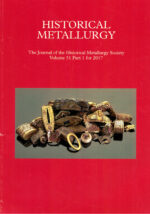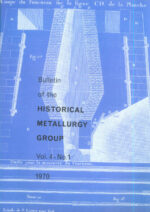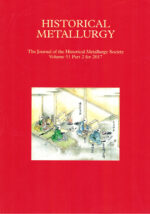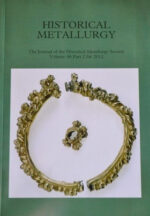Journal Contents
Langley Lead Smelting Mills and James Mulcaster's description of 1806
S M Linsley
Pages 1-18
An outline history of the Langley and Blagill lead smelt mills at Langley, Haydon Bridge, Northumberland, both constructed by the Commissioners for the Greenwich Hospital, provides the context for plans of both mills dated to 1805, and for an 1806 ‘Description of the works at Langley Mill’ written by a James Mulcaster, here published for the first time. This ‘Description’ complements a 1795 account of lead ore smelting in the North Pennine Orefield, also by a James Mulcaster, which was transcribed and published in 1971. The history and the ‘Description’ illustrate technical, economic, and to some extent social changes in the industry on the orefield which was always the most important in Britain, from the 1760s to its late nineteenth-century decline. The Greenwich Hospital’s withdrawal from direct involvement in smelting in the 1830s, coupled with the considerable changes in its local administration, show the effect of a ‘wind of change’ blowing through the industry in the difficult thirties.
Percy Armstrong (1883-1949): A transatlantic pioneer of alloy steels
Bernard Armstrong and Geoffrey Tweedale
Pages 19-24
Modern commercial alloy steels are little more than a hundred years old. Before that date, it was assumed, even by the most knowledgeable metallurgists and engineers, that steel was a fairly uniform item—a mixture of iron and carbon—whose quahties, although extremely useful, were essentially hmited. Steel, as was well known in the nineteenth century, could be heattreated to improve its hardness, but that was all. The idea of adding elements to enhance the qualities of steel—say its hardness, or corrosion-resisting properties-—-was almost unknown. But today alloy steels have become so ubiquitous that we take them for granted. Each day we come into contact with hundreds of alloy steel items, or are transported or accommodated in structures that are made of alloy steels or depend on them in their construction. Some of us will even have our lives saved (or perhaps ended) by alloy steels.
Metallurgy of two fragmentary Archaic Greek Helmets
P H Blyth
Pages 25-36
Two fragments from what had been thought to be a single helmet of the 6th century BC are shown by chemical analysis to come from different helmets, though they share characteristics not seen in other helmets of that type for which analyses have been published. Metallographic examination shows that, though some pre-formation of the blank is probable, both were formed by hammering and each shows a distinct style, indicating that they were made by different armourers. One method of hammering appears to have been very laborious, producing a layer of work-hardening on the outer surface over a ductile core and inner face. Experiments to reproduce this structure and test its effect on deflection and resistance to perforation are described.
Notes on lead metallurgy in Sardinia during the Nuragic period
C. Atzeni, L . Massidda, U . Sanna and P. Virdis
Pages 97-106
Evidence of lead working in Sardinia dates back to the Chalcolithic culture of Monte Claro (-2400 BC). Lead artefacts of the Nuragic period (-1800-500 BC) are a regular occurrence on a large number of sites. Deposits rich in galena, along with the fact that these ores are readily reducible, make lead a metal of particular interest in investigations on the beginning and development of metallurgy on the Island.
The materials examined here include cramps for pottery repairs, sheets, fragments of ingots and metalworking scraps recovered from the sites of Genna Maria (late Bronze/early Iron Age), Antigori (middle Bronze Age) and Santa Barbara (late Bronze/early Iron Age). Chemical and metallographic studies did not reveal any significant differences in the characteristics of the metal in respect either of function of the find or of site. The metal is of high purity, more so than modem lead bullion and may have been produced by treating lead ores containing high proportions of PbS by the ‘charcoal hearth’ technique.
The introduction of coke iron at the Stour forges of the Knight family
Laurence Ince
Pages 107-
The Knight family’s interest in the iron industry dates as far back as the middle of the seventeenth century. However, the family’s fortune in the trade was based on the activities of Richard Knight (1659-1745). By the end of the seventeenth century he was working Morton Forge in Shropshire and also leasing the Flaxley Furnace in the Forest of Dean. The iron industry of the Enghsh midlands was at this time dominated by the activities of the Foley family. The Foley’s extensive interests were organised into a series of partnerships. However, these partnerships had become rather unwieldly and so as the Foley family rationahsed and reduced their industrial empire, other investors like the Knight family moved in to fill the vacuum. One of these groupings was called. The Ironworks in Partnership and by 1707 Richard Knight had joined this venture which operated furnaces and forges in the Forest of Dean and the Stour valley. Although by 1725 Knight had withdrawn from this partnership he continued his interest in the Stour valley by leasing forges at Cookley and Whittington. Richard Knight had also been busy elsewhere for by 1700 he was working the Bringewood Furnace and Forge in Shropshire and in 1712 he purchased the Charlcot Furnace in the same county^. The Knight interest in the Stour valley was further expanded when Richard Kjiight became a member of The Stour Partnership in 1726. This partnership operated the Hales Furnace. Knight brought into this partnership the forges at Cookley and Whittington and these provided ready outlets for the pig iron made at Hales. Richard Knight was to extend his iron making interests by becoming a partner in Cheshire ironworks and also by taking over Willey Furnace in Shropshire which had been partly operated by his brother Francis.





There are no reviews yet.